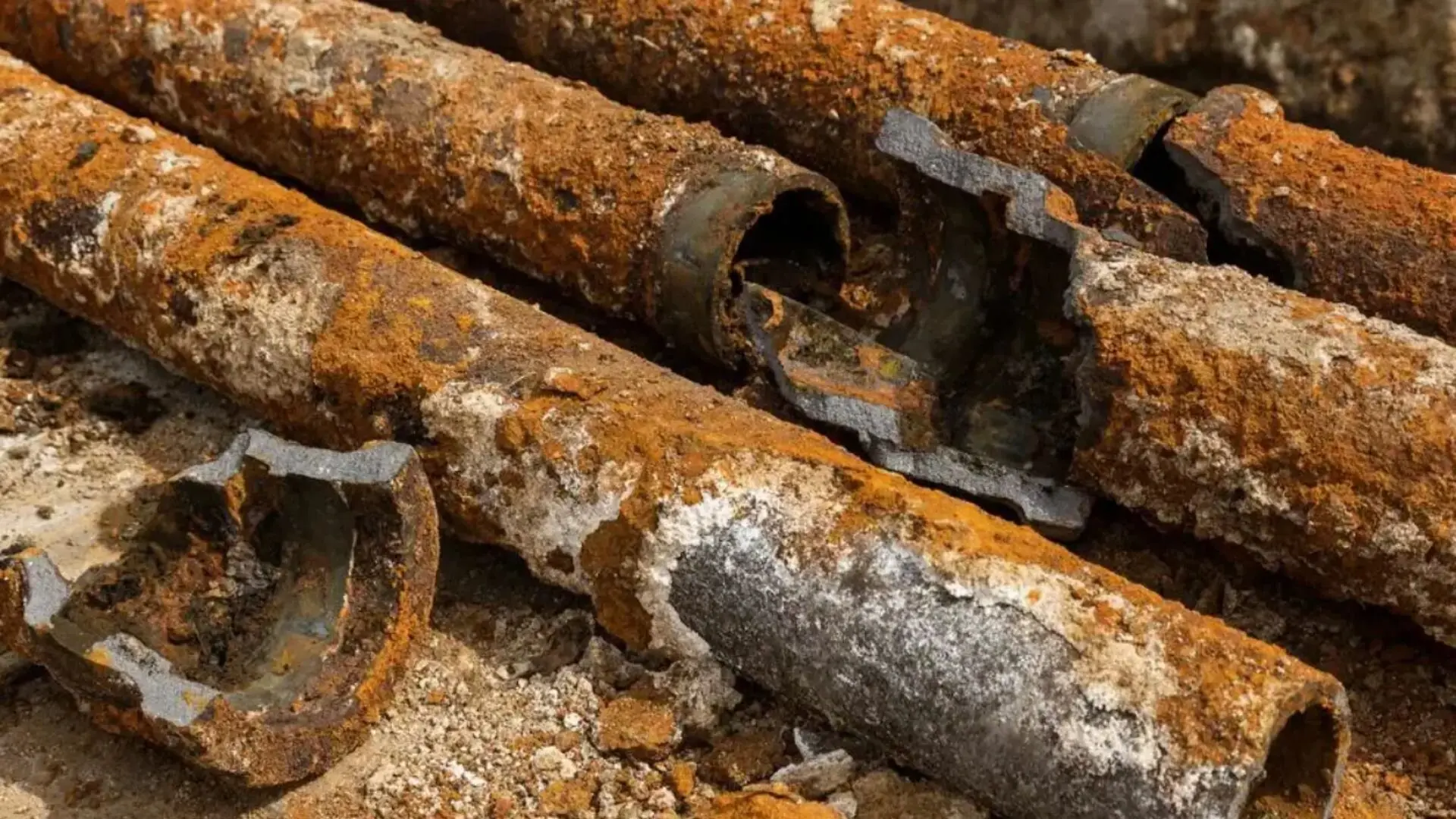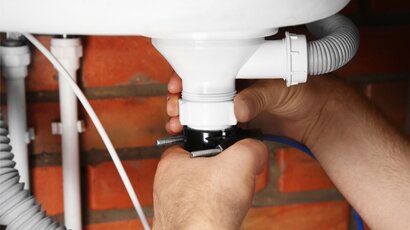Think of your plumbing system as your home’s lifeline—it delivers clean, safe water whenever you need it. But when hidden corrosion starts to eat away at your pipes, things can go wrong quickly.
Unchecked corrosion can threaten your home’s plumbing with major leaks, clogs, reduced water pressure, and even lead and other metal contamination of your drinking water. However, by being proactive and learning to spot early signs of corrosion build-up, you can detect issues before they cause expensive damage.
This comprehensive guide will show you some straightforward DIY methods to check your plumbing for corrosion. You’ll learn how to keep an eye on water quality, inspect pipes and fixtures visually, and use a multimeter to detect corrosive ions. Plus, we’ll talk about when it’s time to call in a plumber for a thorough check using cameras and leak detectors.
Arm yourself with the knowledge to keep your water flowing efficiently and your pipes in peak condition by stopping corrosion. Protect your home now and avoid headaches down the road.
Understanding Corrosion in Plumbing
Corrosion is the gradual wearing away of metal piping caused by a chemical reaction between the metal surface and water or environments.
Several factors can speed up corrosion in plumbing systems. The pH and mineral content of water, oxygen levels, the materials and methods used in pipes, and external conditions like moisture and soil acidity all play a role.
![]()
Types of Corrosion in Plumbing Systems
Three main types of corrosion can negatively impact residential plumbing systems:
Galvanic Corrosion
This occurs when two dissimilar metals are joined in a plumbing system and react against each other. One metal will corrode faster than the other, such as copper pipes connected to iron fittings.
Pitting Corrosion
Over time, small holes and pits start forming on the metal surfaces of the pipes. This is often caused by aggressive water properties or the presence of bacteria.
Erosion Corrosion
The constant flow of water steadily erodes and wears away the inside lining of pipes. Harder water and higher flow rates accelerate erosion over time.
Catching and remediating any corrosion early is critical to avoiding major plumbing headaches like pipe bursts, water leaks, flooding, and potential contamination of drinking water from the corrosion of lead or copper pipes. Routine inspection and testing allow early detection and prevention of corrosion issues before they escalate.
Detecting Signs of Corrosion in Your Plumbing
Be on the lookout for these common indicators that may signal corrosion is occurring in your home’s plumbing system:
- Discoloured Water - Rusty, brownish, greenish or yellowish water from the taps may indicate corroded pipes and plumbing fixtures. Particles of corroded metal cause discolouration and an unpleasant metallic taste.
- Foul Odors— An odour of rotten eggs or sewage from the hot water taps can indicate corrosive bacteria build-up inside your water heater or pipes.
- Frequent Leakage - Corrosion damage and pinhole pipe leaks will cause visible water damage. Watch for damp spots on walls or ceilings, especially near joints and elbows.
- Dropping Water Pressure—Corrosion debris builds up inside supply pipes, restricting water flow and decreasing water pressure from faucets and shower heads.
- Clanging Noises - Loud banging or clanging noises from pipes point to advanced corrosion with thinning and structural weakness in pipes.
- Flaking Fixtures - Noticeable greenish or white crusty mineral deposits around faucet fixtures indicate corrosion is actively occurring.
With corrosion, the unseen damage happening inside pipes poses the greatest threat. As corrosion perforates supply pipes, it allows heavy metals like lead and copper to leach into drinking water, creating a major health hazard. Stay vigilant in monitoring your plumbing for any signs.
![]()
DIY Methods for Testing Your Plumbing for Corrosion
Use these DIY techniques to inspect your plumbing system for early signs of corrosion periodically:
Method 1: Water Quality Testing
You can test your water supply for factors that may speed up corrosion. Start by checking the pH level with litmus strips. If it’s below 6, you’ve got acidic water, which isn’t good for your pipes. Then, look at the mineral content. Hard water packed with minerals can coat your pipes and eventually restrict the flow.
Finally, check for contaminants like iron, chlorine, and sulphur, which are corrosive substances. Performing these water quality tests periodically allows you to monitor for conditions ripe for corrosion.
Method 2: Visual Inspection
When you’re doing a visual inspection, take a good look at all visible pipes, joints, fittings, and fixtures. Keep an eye out for rust spots, pitting, leaks, damp patches, or mineral deposits that suggest corrosion.
Don’t forget to check connectors, elbows, and joints for any build-up. Lastly, have a close look at faucets and valves for that greenish crusty film, which means corrosion is happening. This kind of inspection can help you catch problems before they get worse.
Method 3: Multimeter Conductivity Test
You can use a multimeter to measure the electrical conductivity of tap water samples. Higher conductivity readings indicate that more corrosive ions are present in the water. Take conductivity measurements over time and compare the results.
Any measurement increase may point to advancing corrosion in the plumbing system. Monitoring conductivity changes allows early detection.
Method 4: Infrared Camera Inspection
Another useful inspection method is using an infrared camera. Aim the camera at pipes to identify any cold spots that may indicate underlying corrosion issues. The camera can also check for temperature differences along the pipes, especially under insulation.
Areas with uneven heating patterns or unexpected temperature variations can signify problem spots where corrosion develops. Infrared imaging serves as an excellent tool for early detection of corrosion.
Getting a Professional Corrosion Assessment
While DIY testing methods are helpful for preliminary checks, it’s wise to have a professional plumbing inspection done at least annually to evaluate your entire system thoroughly for hidden corrosion. Plumbers have access to advanced tools and techniques to identify issues you might miss on your own.
For example, plumbers can snake high-resolution pipe inspection cameras deep inside your pipes to visually examine areas for corrosion that can’t be seen externally.
![]()
Ultrasound testing is another method plumbers use to measure pipe wall thickness in key locations using soundwaves. This method detects thinning and holes caused by corrosion. Plumbers also perform isolated pressure testing by closing off sections of plumbing and pressurising them to check for leaks that would indicate corrosion damage.
A professional plumber can detect corrosion and advise on necessary repairs and preventative maintenance. Options like pipe flushing help remove mineral deposits and debris to improve water flow.
Installing an anode rod provides a sacrificial metal that absorbs corrosion instead of your pipes. Water softeners and filtration systems control water chemistry to be less corrosive. Protective epoxy coatings can be applied inside pipes as a barrier from corrosion.
With regular professional corrosion assessments and following the plumber’s recommended prevention practices, you can keep your plumbing system free of hidden damage and running safely and efficiently.
Protect Your Plumbing from Corrosion Damage
Catching early corrosion is critical to avoiding major plumbing headaches like leaks, floods, and contamination of drinking water. Use this guide to monitor your system for warning signs and take prompt action if corrosion is detected. Perform routine DIY tests and contact a licensed plumber annually for a professional corrosion assessment.
The plumbing experts at WP Plumbing in Melbourne have extensive experience inspecting and repairing corrosion damage. Contact our professional team today to evaluate your plumbing system’s health and pipe corrosion risks. We offer affordable camera inspections, leak detection, repairs, and preventative maintenance to keep your pipes corrosion-free.
Protect your home, health, and water supply by prioritising corrosion prevention. WP Plumbing has the tools and know-how to detect issues before they cause expensive emergencies. Contact us today to schedule your plumbing corrosion inspection and keep your water flowing safely.






